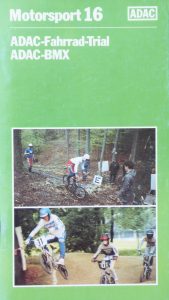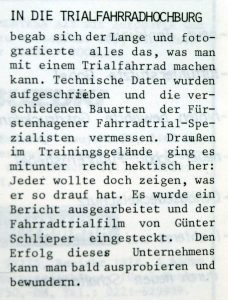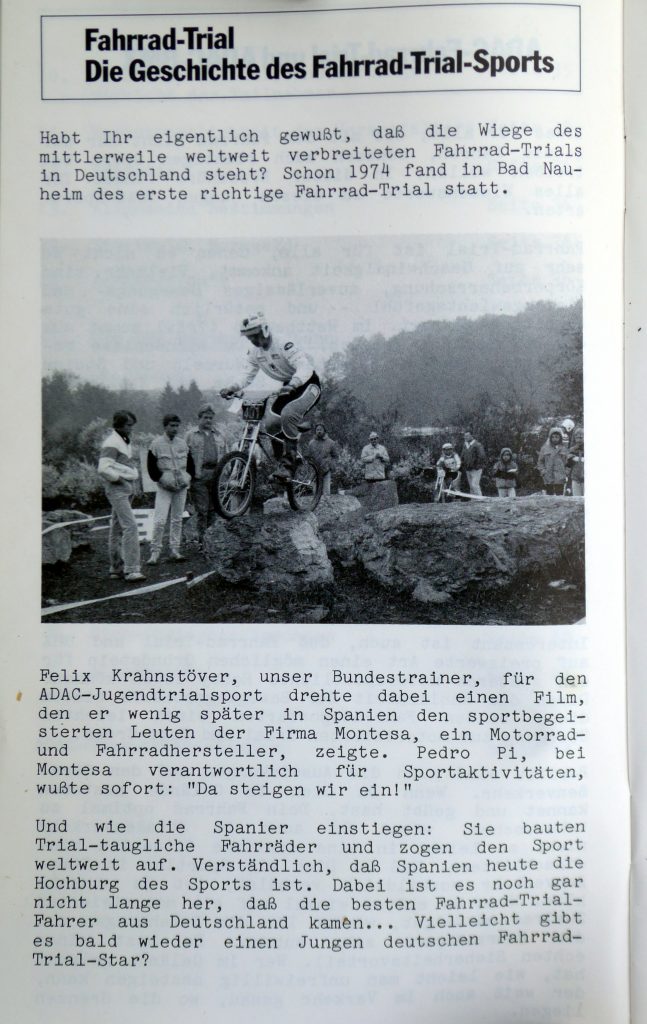The news brought by Felix Krahnstöver about German bicycle trials was a key moment for Pere Pi. From his point of view, everything now pointed to bicycle production. First of all, there was the positive example of the Montesa Cota 25 children's trial motorcycle, which was still in production at the time and had been a great commercial success a few years earlier during the boom in motorcycle trials. 1 Such an upswing now seemed to be on the horizon for bicycle trials as well, guaranteeing the commercial success of trial bikes. At the same time, BMX spilled over from California to Europe. Pere Pi tried to jump on the bandwagon here too with a BMX bike based on the 20-inch trial bike, the C-10. 2 The fact that both off-road disciplines of motorcycle racing, trial and motocross, were now apparently also developing into cycling disciplines probably reinforced his expectations of success in bicycle production.

The economic interest in sales was matched by an interest in promoting bicycle trials and BMX. Added to this was the fact that Pere Pi had been Spanish champion in both disciplines, trials and motocross. This resulted in not only an economic but also an emotional interest in promoting Ot in these two areas – Ot also competed in BMX at the beginning. If Ot did not become a successful motocross or trials rider on a motorcycle, then he would do so on a bicycle. Economic, organizational, and personal interests went hand in hand. Pere Pi now made bicycle trials his own thing, and he had the opportunities to do so at Montesa. 3
Pere Pi then brought Andreu Codina (Andreu Codina i Candelas, born 1964) to Montesa, who was the best bicycle trials rider from San Feliu de Codines at the time and became Catalan champion in 1978 and 1979 on the Fidan (Figueras – Dandi) built by Josep Figueras, to develop a proper trials bike for older teenagers, the T-15. At the age of fifteen, Codina became the first factory rider in bicycle trials and, at the same time, something of a personal trainer for Ot, who was six years his younger. As a basis for the development of the T-15, Pi collected data on existing trials bikes, including Josep Figueras' Fidan, studied Eliseu Sellès' double bridge fork in Sabadell, and commissioned Felix Krahnstöver to measure the bikes in Fürstenhagen. At the same time, the series production of Ot's trials bikes, which had not yet undergone any systematic development work, was pushed forward as the T-5 and T-10. 5

In the summer of 1979, Felix Krahnstöver stopped in Fürstenhagen on his way to Spain to measure the Schlieper bicycles. Günter Schlieper was not there—his wife led Felix to the basement where the bicycles were kept—Felix was a regular visitor to Fürstenhagen and was very familiar with the Schliepers. Nevertheless, Günter Schlieper was annoyed afterwards that he had not been asked about the measurements of the bicycles. In addition to the data on the Schlieper bicycles, Felix also took the promotional film for bicycle trials, which Günter Schlieper had shot, with him to Pere Pi in Barcelona (see illustration on the left). Felix Krahnstöver wrote to me in a letter in 1990: "He (Pere Pi) got hold of a projector, and so the Spanish premiere of a Super 8 film by Schlieper from Fürstenhagen, showing the boys training, took place. Incidentally, Mr. Canellas was also present that evening; he was and is the director of the Montesa factory. (...)
During my next visit—in the fall of 1979—he had already assembled the first prototypes in his garage at home (...). 6
The ADAC brochure “Motorsport 16 – ADAC Bicycle Trial, ADAC BMX” from 1984 not only documents the date of the oldest bicycle trial, which marks the beginning of the development of today's bicycle trials, namely the bicycle trial on May 25, 1974, in Bad Nauheim (which not only took place nine months before the first Catalan “Trial en bicicleta” in Calella on February 15, 1975, but was also organized primarily to promote bicycle trials. The bicycle trial in Bad Nauheim then set the ball rolling in Germany), but also Felix Krahnstöver's role as a mediator between German bicycle trials and Pere Pi.
I am reproducing excerpts from the text on page 6 of the ADAC brochure “Motorsport 16” shown below so that it can also be read in the English translation:
Bicycle trials – The history of bicycle trials as a sport
"Did you know that Germany is the birthplace of bicycle trials, which are now popular all over the world? The first proper bicycle trial took place in Bad Nauheim back in 1974.
Felix Krahnstöver, our national coach for ADAC youth trials, made a film about it, which he showed shortly afterwards in Spain to the sports enthusiasts at Montesa, a motorcycle and bicycle manufacturer. Pedro Pi, responsible for sports activities at Montesa, knew immediately: “We're in!”
And how the Spanish got involved: they built bikes suitable for trials and promoted the sport worldwide. It's understandable that Spain is now the stronghold of the sport."
It should be noted here that, as already mentioned above, it was not Krahnstöver who made the film, but rather Günter Schlieper, who shot the promotional film for bicycle trials, which Krahnstöver brought to Pere Pi (then still Pedro Pi). Montesa was actually purely a motorcycle manufacturer and only became a bicycle manufacturer through the production of the “Montesita” trials bikes. The ‘Montesitas’ were produced by Montesa “on the side,” so to speak.

All these events were familiar to everyone involved in German bicycle trials at the time. When the Spanish bus carrying the participants in the first European Cup appeared at the German round in Fürstenhagen in early July 1982 with a large banner reading “Trialsin – Un esport nascut aqui” (“TRIALSIN – a sport that originated here” – i.e., in Catalonia) in the rear window, it was generally perceived as strange and bizarre. Günter Schlieper later told me that he had “tried” to talk to Pedro Pi about it and told him that the bicycle trial in Bad Nauheim in 1974 had been the first bicycle trial, but that it had been ‘pointless’ – “At some point, I just left him standing there and walked away,” he told me at the time, visibly dismayed.
- https://ca.wikipedia.org/wiki/Montesa_Cota_25 from 14 March 2019 ↩
- In Pere Pi's autobiography, the earliest date mentioned in the entire BMX chapter is 1982 – all other dates are later. Nevertheless, the chapter heading refers to “1976,” the alleged and implausible year of manufacture of the Montesita T-10, on which the C-10 was based. Pere Pi: No tengo 200 años, 2012, pp. 317-321. In reality, the T-10 was not produced until after Felix Krahnstöver's visit in March 1979. See the page “Felix Krahnstöver and Pere Pi” and notes 4 and 5 below. ↩
- When asked about his boss's approval of his cycling activities, Pere Pi replied in an interview for Retrotrials: ‘I was the boss, ha ha ha’; https://www.retrotrials.com/15–pere-pi—off-road-motorcycle-pioneer-and-montesa-development-boss.html 11 March, 2019 ↩
- In his review of the T-10, Felix Krahnstöver wrote: ‘The handlebar mounts and steering head bearings are from the Cota 349, so it could hardly be any more stable’; TRIALSPORT No. 47, February 1980, p. 41. Looking back, Andreu Codina described the T-10 as ‘junk’ in comparison to the Figueras and the T-15, saying that it was ‘not suitable for bicycle trials’; https://www.retrotrials.com/page-5—2013-feature-interview—andrew-codina.html from 12 March 2019. The significant difference in quality between the T-5 and T-10 on the one hand and the T-15 on the other is evident in the 1981 advertising photo, not only in the bicycles themselves, but also in the faces of the children pictured – Ot Pi on the left! https://ca.wikipedia.org/wiki/Montesita#/media/File:Montesita_T-15_brochure_1981.png ↩
- The T-10 went on sale in November 1979, eight months after Felix Krahnstöver's visit. https://ca.wikipedia.org/wiki/Montesita from 4 April 2019. The T-5 followed somewhat later in 1980. In the presentation of the T-10 in TRIALSPORT No. 47 (February 1980), Krahnstöver writes on page 40: ‘The MONTESITA T5 will also be available soon.’ ↩
- Letter from Felix Krahnstöver to me dated 18 October 1990 ↩